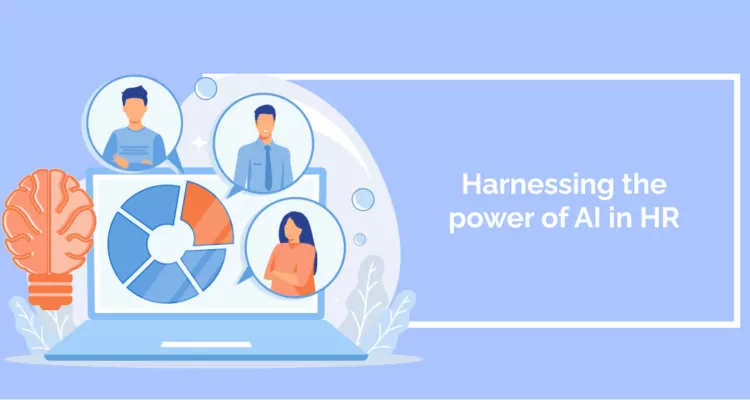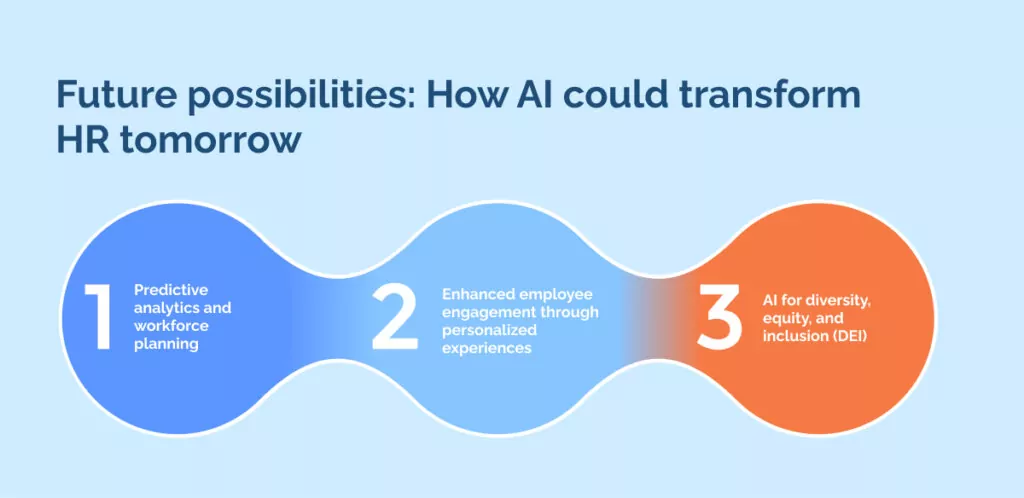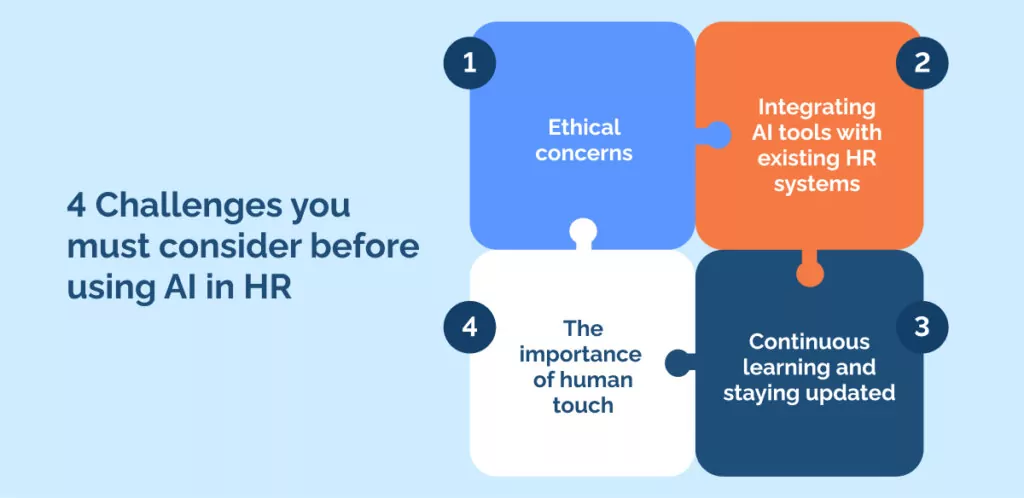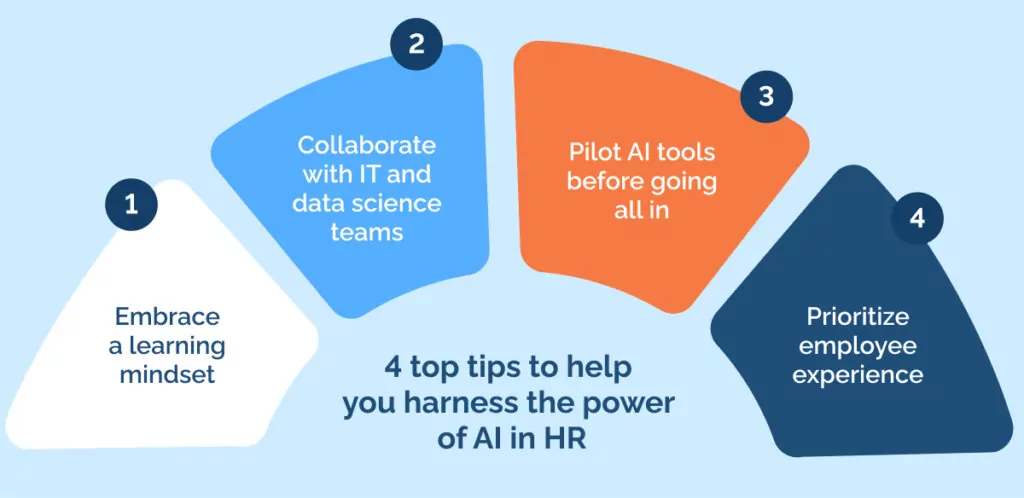
We’ve all seen HR evolve over the years.
Remember the days of purely manual recruitment and annual appraisals?
Today, HR processes are more sophisticated, data-driven, and centered around the employee experience.
The transformation has been vast, and understanding this shift can provide valuable insights into where HR is headed next.
You’ve undoubtedly heard the buzz around artificial intelligence (AI).
The hype around AI has bloomed this year, and unquestionably, AI will play a part in the future of work.
Industries across the board, from healthcare to finance, are integrating AI to optimize their operations. And now, the HR landscape is no exception.
With AI’s increasing influence, it’s crucial to understand how it’s shaping HR, presenting both opportunities and challenges for businesses like yours.
In this article, we’re shining a light on the intersection of AI and HR.
We’ll cover how AI is used by HR leaders today and how it might be used in the future.
If you want to use AI to augment your HR processes, we will share a few top tips to help you along the way and a handful of challenges you should be aware of before you begin.
The current landscape: AI’s role in HR today
Make no mistake, while AI feels like the future, it’s already here with us in the present.
A 2022 report by Eightfold AI found that over 70% of HR leaders are using AI to support functions ranging from records management to payroll processing to recruitment.
Furthermore, 92% of HR leaders said they intend to increase their AI use.
So, where exactly is AI making its mark in HR today? What are innovative HR leaders using it for?
Here are a few examples:
Recruitment tools
Let’s admit it: Sifting through thousands of resumes manually is tedious.
With AI, you can now streamline and enhance the hiring process. Even the experts agree:
“I think it’ll reshape recruiting in two meaningful ways,” says Talent Leader Bryan Hancock on the Mckinsey Talks Talent show.
“The first is helping managers write better job requirements […] The other application in recruiting is candidate personalization.”
From chatbots answering prospective candidate queries to advanced algorithms that match job requirements with candidates’ skills, AI is revolutionizing modern talent strategy.
Onboarding automation
Integrating new team members is a real challenge. You’re under pressure from all sides to:
- Provide a great employee experience
- Minimize the new employee’s time-to-value
Those two goals often feel like they’re fighting against one another. It can be hard to find the balance.
An AI-driven automation platform can now guide new hires through paperwork, essential training, and company culture introductions, ensuring you provide a smooth start and a lasting first impression.
AI-driven employee surveys and feedback
Gone are the days of generic annual feedback forms.
Today, you can use AI to generate real-time feedback, analyze employee sentiments, and even predict future trends in employee satisfaction.
This gives you a pulse on your workforce like never before.
Not only does AI make it easier to measure digital employee experience, but it also makes it easier to analyze any data you collect.
The edge given by AI: Benefits seen by HR pioneers
Early birds do get the worm, especially in the world of technology.
Here’s what early adopters of AI in HR have gained:
Increased efficiency
No more spending hours on manual tasks.
With AI, you can automate repetitive processes, allowing your HR teams to focus on strategic activities that truly matter.
Reduced biases
Let’s face it. Unintentional biases can creep into hiring and appraisal processes.
With AI’s objective algorithms, you can ensure a more level playing field, promoting diversity and fairness in your workforce decisions.
It’s worth noting, however, that AI can cause more issues with bias than it solves. We’ll address that in a later section.
Improved employee experience
Happy employees lead to thriving businesses.
An article by the Harvard Business Review found that on a 1 to 5 scale of employee satisfaction, for everyone one level improvement, there was a corresponding improvement of anywhere from 8% to 19% in long-term market valuation.
AI tools offer personalized experiences, from tailored learning paths to prompt grievance redressal, enhancing overall job satisfaction and loyalty.
That’s an advantage you want on your side.
Future possibilities: How AI could transform HR tomorrow

We’ve taken a snapshot of how AI is being used today.
Now let’s look at how you could use it tomorrow.
The possibilities are endless. So we will focus on 3 strong future use cases for AI in HR.
These are:
1. Predictive analytics and workforce planning
Envision a future where uncertainties in HR are minimized and you’re ahead of the curve.
AI can help you get there by:
Understanding employee turnover
Why did your star employee leave?
Could you have done something to retain them?
Using predictive analytics, AI can alert you to early signs of employee dissatisfaction, allowing you to intervene and retain top talent.
Identifying future talent needs
Imagine knowing the skills and roles you’ll need a year from now.
With AI, you can analyze market trends, internal company data, and project trajectories to anticipate and fill talent gaps before they even appear.
2. Enhanced employee engagement through personalized experiences
When it comes to engaging employees, there are no one-size-fits-all solutions.
It’s about understanding and catering to individual needs, and AI is paving the way through:
Personalized training recommendations
Instead of generic training modules, AI can analyze an individual’s performance, preferences, and career aspirations to suggest tailored learning opportunities.
This way, you’re not just training but helping employees grow in their desired direction.
AI-driven career path suggestions
From time to time, everyone thinks to themselves, “Where do I go from here?”
AI can take an employee’s skills, experiences, and aspirations into account to chart out potential career paths, showing them possibilities they might not have considered and giving them a roadmap to achieve their goals.
3. AI for diversity, equity, and inclusion (DEI)
Diversity is a business imperative.
And AI can ensure you’re not just talking about DEI but truly implementing it by:
Identifying and mitigating unconscious biases
Unintended biases can influence decisions, from hiring to promotions.
AI can help by pointing out patterns that might indicate bias, allowing you to make corrections and ensure fairness.
Sourcing diverse talent pools
You want the best talent, irrespective of their background.
AI-driven tools can help you reach out to diverse candidate pools by suggesting platforms, communities, or initiatives where you can connect with a broad range of talents.
Thus ensuring your organization truly represents the world outside.
4 Challenges you must consider before using AI in HR

Change is challenging.
While AI can do a lot to make your day easier, it’s not a miracle tool, and you will face a handful of challenges.
Making yourself aware of them now will help you deal with them later.
This list isn’t exhaustive, but we think the most significant challenges AI poses to HR leaders are:
1. Ethical concerns
While AI offers many benefits, it also raises significant ethical dilemmas that you need to address:
Data privacy and protection
Collecting and analyzing employee data isn’t without risks.
How do you ensure the data is stored securely? Are employees aware of how their information is used?
Prioritizing data protection is paramount to maintaining trust.
Avoiding algorithmic biases
It’s a misconception that AI is entirely neutral.
If not trained correctly, AI can reinforce existing biases.
You’ll need to ensure the data and algorithms you use are scrutinized for fairness and objectivity.
2. Integrating AI tools with existing HR systems
Introducing AI into your HR processes isn’t just buying a new software solution.
How will these tools integrate with your current systems? Is there potential for friction or gaps?
Smooth integration is crucial to maximize benefits and avoid disruptions.
3. The importance of human touch
Remember, while AI is powerful, it doesn’t replace the nuances of human judgment.
AI can analyze data and spot patterns, but understanding the complexities of human emotions and motivations is where you come in.
Ensuring that AI complements rather than replaces human interactions will be the key to maintaining a genuine, empathetic workplace.
4. Continuous learning and staying updated
The world of AI is ever-evolving.
What’s cutting-edge today might be obsolete tomorrow.
Fostering a culture of continuous learning and ensuring your HR team is always abreast of the latest AI advancements will be crucial in maintaining your competitive edge.
To achieve that, you’ll need a robust employee training plan.
4 top tips to help you harness the power of AI in HR

Feeling inspired?
Ready to dig deeper into the AI rabbit hole and explore how you could use it to bolster your AI processes and drive business growth?
Don’t go anywhere without reading our 4 top tips to help you get the most out of AI in HR.
Tip #1 Embrace a learning mindset
AI is changing the way you approach HR, but remember this:
It’s just a tool.
Instead of seeing it as a complete solution, view it as a valuable assistant.
By fostering a mindset open to change and committed to understanding AI’s nuances, you’ll position yourself to harness its full potential without becoming overly reliant on it.
Tip #2 Collaborate with IT and data science teams
To truly grasp what AI can and cannot do, you need to break down silos.
Engage with your IT and data science colleagues regularly. Their technical insights will guide you in selecting the right tools and understanding the limitations.
With combined expertise, you can craft an AI strategy that’s both robust and relevant.
Tip #3 Pilot AI tools before going all in
Jumping headfirst might seem tempting, especially with the promise of AI’s benefits.
However, it’s always wise to test the waters.
Before rolling out any AI solution across the organization, pilot it with a smaller group. This trial will help you gauge its effectiveness, refine its parameters, and anticipate any challenges.
Tip #4 Prioritize employee experience
At the end of the day, HR is about people.
Any AI solution you adopt should enhance the employee experience, not detract from it.
Whether it’s ensuring data privacy or making sure AI recommendations are relevant and personalized, always keep the well-being and satisfaction of your employees at the forefront of your AI endeavors.
AI in HR: Force to be reckoned with, or fleeting trend?
Here’s our take:
We’re on the brink of a significant transformation.
AI is not just a fleeting trend; it’s a catalyst reshaping HR practices’ very fabric.
The potential is vast and exciting, from optimizing mundane tasks to offering predictive insights into workforce trends. But as with any powerful tool, its impact is determined by how you wield it.
Now, the onus is on you.
The future of HR lies in the delicate balance between technological advancement and the human touch.
Embrace the possibilities AI offers, but remember, at the heart of HR is the human experience. Let AI be a tool that enhances this experience, not one that overshadows it.
WalkMe Team
WalkMe spearheaded the Digital Adoption Platform (DAP) for associations to use the maximum capacity of their advanced resources. Utilizing man-made consciousness, AI, and context-oriented direction, WalkMe adds a powerful UI layer to raise the computerized proficiency, everything being equal.



